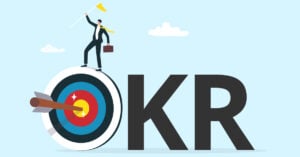If you’re looking for a better way to structure strategic goals, improve alignment and focus your organisation’s efforts, you have likely come across the term OKRs. Short for Objectives and Key Results, this goal setting framework offers a structured format that allows businesses to define priorities clearly, measure outcomes effectively, and link strategy to execution. The OKR structure brings consistency to how goals are set, tracked and delivered across different levels of an organisation.
While the OKR format can be adapted to fit various industries or team setups, it works best when underpinned by a consistent structure that flows from your long-term strategy. That’s why our approach starts by anchoring OKRs to your organisation’s core vision, before breaking them down into more manageable layers that teams can work with. If you’re currently exploring how to implement OKRs or searching for an OKR structure, we will walk you through the fundamentals and provide a practical model you can apply.

Start by Defining the Long-Term Vision
A clear strategic vision is the backbone of any effective OKR structure. This vision should typically cover a three to five year period and act as a reference point for how you want your organisation to evolve. This could include entering a new market, becoming market leaders, scaling operations, or improving customer experience at scale.
Central to this vision are what we call ‘big moves’ – strategic initiatives that reflect the major shifts needed to deliver your long-term outcomes. Big moves are not annual tasks. They tend to span multiple years, are reviewed regularly, and provide a clear signal to the rest of the organisation about where energy and resources should be focused. By establishing these moves early, you create a strong link between strategy and the OKRs that follow.
Building the OKR Structure in Three Levels
Once your strategic vision and big moves are defined, the next step is to break that vision down into objectives. These objectives allow you to translate high-level ambition into goals that can be delivered and measured in the short and medium term. We use a three-tiered OKR structure to help organisations achieve this.
- Company-wide Objectives (Annual)
At the top of the structure are your company-wide objectives. These reflect the business’s main priorities for the year and are designed to keep teams aligned on shared outcomes. While these objectives are set annually, we recommend reviewing progress on a quarterly basis to maintain agility and ensure focus remains consistent. Company-level OKRs often reflect progress against your big moves. For example, an objective to ‘Increase market share in Region X’ might be supported by key results related to customer acquisition, product development or brand awareness.
- Transformational Objectives (Quarterly)
Sitting beneath company-wide goals are transformational objectives. These are set quarterly and focus on strategic projects that require cross-functional collaboration or drive meaningful change in a specific area of the business. These objectives help to connect your annual focus with practical execution and are often where the heavy lifting of change happens. Because they typically involve multiple teams, they also encourage joined-up thinking and shared accountability. For example, a transformational objective could be to ‘Improve lead conversion through better onboarding’ with key results measuring system updates, user journey improvements and drop-off rate reductions.
- Local Objectives (Quarterly)
Finally, local objectives are created at the team or departmental level. These are more specific and often tailored to a team’s area of expertise, but they must remain aligned with the transformational or company-wide goals. Local objectives give teams clarity on where they can add value and how their work contributes to wider outcomes. They’re also reviewed quarterly and should follow the same principles as all OKRs: measurable, time-bound and outcome-focused. This level of structure empowers individuals to take ownership of goals while staying connected to the broader strategy.

Why the OKR Structure Matters
An OKR structure gives your strategy the support it needs to be delivered consistently across the business. Without this structure, it’s easy for teams to drift into separate directions and lose sight of the bigger picture. By connecting company-wide objectives to departmental activity, you can avoid misalignment and make better decisions about where to invest time and energy.
This way of working helps organisations stay focused on what matters while giving teams the confidence to execute effectively.
If you’re starting out with OKRs or reviewing your current approach, we recommend reading our goal setting guide. Taking the time to get the structure right can make a real difference to how goals are understood and delivered across your organisation.
If you’d like to speak with a goal setting expert at There Be Giants, you can book a time that works for you.


